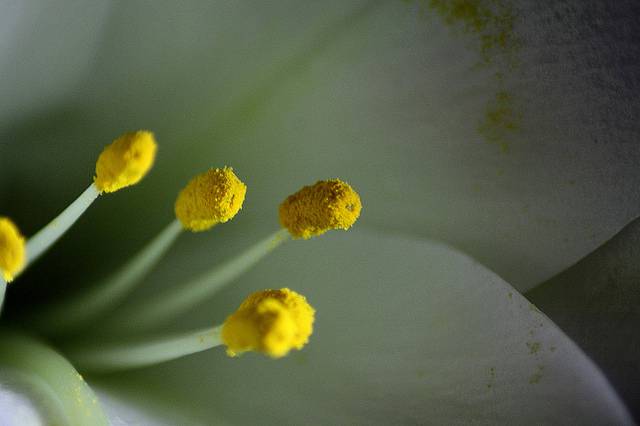Until I became a florist, I assumed that anyone would love to receive a bouquet of beautiful flowers; then, I learned that for people with allergies, sending certain flowers is like sending sickness. For an allergy-sufferer, the wrong flowers can trigger sneezing, itchy, watery eyes, a runny nose, and sinus symptoms. If you suffer from seasonal allergies, you are probably quite familiar with these unpleasant effects. To understand what plants to avoid, it is good to know the science behind pollen allergies.
Plants can be monoecious, which means they have male and female flowers on the same plant, or they can be dioecious, which means the plants are strictly male or strictly female. It is the male plants and male flowers that are responsible for allergies. The male parts are the filament and the anther; together, they are referred to as the stamen. The anther is what produces the pollen that causes us so many problems. Both monoecious and dioecious plants depend on wind to move the pollen from the male to the female plant, and when the pollen becomes airborne, it causes allergies.
Photo via GollyGforce-Living My Worst Nightmare (Flickr)
Some plants have what are known as perfect flowers; they have both male and female parts within the same flower. Consequently, the pollen doesn’t have to depend on becoming airborne to fertilize the female parts because it is so near to them. So these kinds of plants generally do not cause allergies. An example is of a perfect flower is the rose: Thank goodness roses are a safe choice!
So how do you know what kind of plant you are looking at? Chances are you won’t know unless you do some studying. Plants and trees at the nursery rarely have labels saying if they are male or female. However, big, colorful flowers tend to cause fewer allergies than small, drab flowers, and greenish-white flowers are the biggest allergy culprits of all. Trumpet-shaped flowers like daffodils and angel’s trumpet usually don’t cause allergies because the pollen is trapped deep within the flower. It is important to remember that scent is also a concern; a highly scented flower may not hold a lot of pollen, but the fragrance could still make a person sick just from the scent.
When choosing floral arrangements for a person with an allergy, stay away from asters, chrysanthemums, baby’s breath, daisies, and sunflowers. There are some exceptions, though; some double and hybridized varieties have very little pollen. Some lilies have pollen, and some do not: If they do have anthers, those can be cut off by the florist or by you, but be aware that the stamens can leak a sap that can irritate skin. All of these rules can be confusing, so if you are uncertain if a particular flower is a cause of allergies, just ask a florist. It is our job to be knowledgeable about flowers, after all
So what flowers are safe choices to send allergy-sufferers? Irises, gladiolas, daffodils, roses, carnations, peonies, potted houseplants, and orchids are well-loved safe choices. In the garden, salvia, snapdragons, dusty miller, hostas, geraniums, and azaleas are just a few flowers that won’t make you sneeze. If there is a particular plant that you have to have in your garden even though it could cause you trouble, remember not to plant it near any windows that you open or near doors. Do some research to find out if there are more hypoallergenic versions of the plant you like. If considering a tree or shrub, know that there are some trees that are male and some that are female and that it is the male trees that cause allergies. Remembering these tips will have you stopping to smell the flowers without sneezing.
![[Avas Flowers] Avas Flowers](https://www.avasflowers.net/newimg/avas-logo-new.png)

